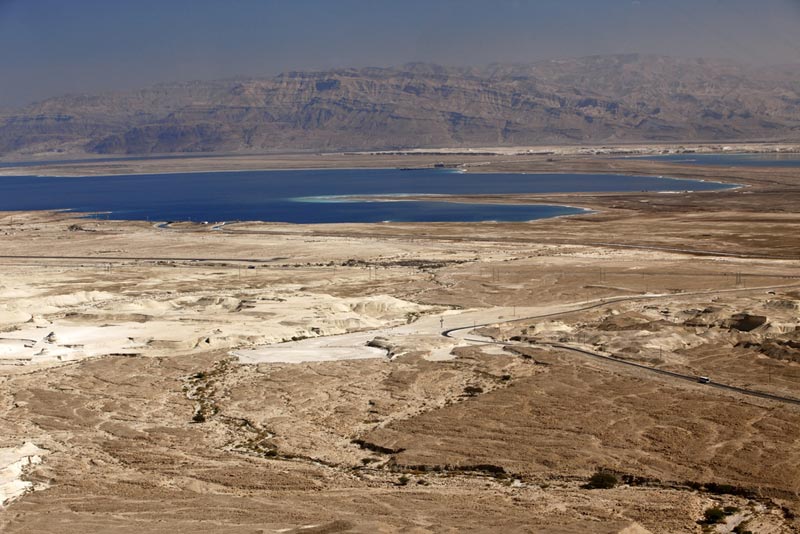Could the Dead Sea Completely Vanish?

SAN FRANCISCO — Water levels in the Dead Sea have been dropping over the last few years as towns and villages in Israel, Jordan, Lebanon, Palestine and Syria suck up run-off water that would normally fill the extra-salty lake. But new research finds that even in periods without human pressures, the Dead Sea may have dried up, including once when it did so almost entirely more than 100,000 years ago.
The finding does not bode well for the region, according to study researcher Steven Goldstein, a professor at the Lamont-Doherty Earth Observatory at Columbia University. If the giant body of water nearly vanished with no human pressures, what could be the consequences with both man-made climate change and water diversions for irrigation that keep much of the resource from even reaching the Dead Sea?
"Without human intervention during the last interglacial, the run-off declined or stopped," Goldstein said here Monday (Dec. 5) at the annual meeting of the American Geophysical Union (AGU). Already, he said, water has been a source of tension in the region.
With climate change, the Dead Sea region is expected to become more arid, resulting in more pressure on water resources. And recent signs suggest things are already happening; in 1930 the lake's surface was 1,280 feet (390 meters) below seal level, dropping to 1,381 feet (421 m) below sea level in 2008 due to water being used up by humans before it could even reach the lake, the researchers said.
Disappearing sea
The Dead Sea is the lowest continental point on Earth. With 33.7 percent salinity, it's famous for the extra buoyancy swimmers get from its high salt content. But the lake has shrunk and grown over the eons, and the new study finds that those changes have occasionally been very extreme.
As part of the Dead Sea Deep Drill Core Project, Goldstein and other colleagues drilled deep below the lakebed of the Dead Sea in 2010 and 2011 to pull up more than 1,300 feet (400 meters) of sediment in a long column — a record of sediment deposits spanning 200,000 years.
Get the world’s most fascinating discoveries delivered straight to your inbox.
The record captures nearly every season in that time period, Goldstein said, with white layers of a mineral called aragonite marking summer evaporations, when the minerals were left behind as water vanished. Dark layers mark winter floods and sandstorms, which dump dark silt into the lake. The silt then filters to the lake bottom, leaving a record on the lakebed.
The researchers themselves witnessed both of these sorts of events live: At one point, they stood by as a flash flood washed dark sediment into the lake. On another day, a sandstorm with 100 mph (161 kph) winds disrupted their drilling.
Rock layers on the shore had already revealed that the lake has fluctuated in size, filling the entire Jordan Rift Valley during the last Ice Age. But the newly unearthed core showed that during the last interglacial period, about 120,000 years ago, the lake dried up, perhaps entirely. At that point, Goldstein and his colleagues found a layer of round beach pebbles on top of a 147-foot (45-m) layer of mostly salt.
"It looks like the beach deposits that we see on the shore," Goldstein said. But this core was taken in what was then the center of the lake basin.
The find means that at this time, in the warm period before the last Ice Age, the Dead Sea dried up dramatically, leaving its salt behind — "about how much salt we would expect if we were to take the Dead Sea today [and] we were to evaporate it," Goldstein said.
A little help from humans
That past dry-down was climate-driven, said Zvi Ben-Avraham, chief scientist on the project and a researcher at Tel-Aviv University. But today the lake is threatened more directly by humans.
"What we see here happening in the Middle East is something that mimics a severe dry period, but this is not climate-enforced, this is a man-made phenomenon," caused by water being pulled from rivers for irrigation before it ever gets to the Dead Sea, Ben-Avraham said.
Researchers aren't yet sure how long the previous lake dry-down took, but the research has changed their conception of the history of the lake. [A Gallery of Stunning Lakes]
"The global warming scenario is definitely predicting that the area is going to be even drier and warmer than it is today," said Emi Ito, a study researcher from the University of Minnesota. "The previous models of lake-level decline indicated that the lake will not completely dry down, but stabilize at 100 to 150 meters [328 to 492 feet] below current level."
Now, however, Ito said, the core shows that the lake has previously almost entirely disappeared.
"The lake may actually go dry much sooner, because the lake dry-down or almost-dry-down happened 120,000 years ago happened without human intervention," Ito said, "and we're helping the lake dry down much sooner."
You can follow LiveScience senior writer Stephanie Pappas on Twitter @sipappas.Follow LiveScience for the latest in science news and discoveries on Twitter @livescience and on Facebook.

Stephanie Pappas is a contributing writer for Live Science, covering topics ranging from geoscience to archaeology to the human brain and behavior. She was previously a senior writer for Live Science but is now a freelancer based in Denver, Colorado, and regularly contributes to Scientific American and The Monitor, the monthly magazine of the American Psychological Association. Stephanie received a bachelor's degree in psychology from the University of South Carolina and a graduate certificate in science communication from the University of California, Santa Cruz.


